|
|
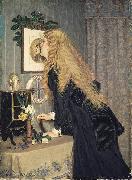 |
William John Hennessy
|
|
(July 11, 1839 - December 27, 1917) was an Irish artist.
William John Hennessy was born in Thomastown, County Kilkenny in 1839. His father, John Hennessy, was forced to leave Ireland in 1848 as a result of his involvement in the Young Ireland movement. He landed in Canada and settled in New York. William, his mother Catherine, and brother joined their father there in 1849. He gained admittance to the National Academy of Design in 1854 and exhibitioned his first works there.
Hennessy developed a skill in wood engraving and was hired to illustrate the works of renowned poets, including that of Tennyson, Longfellow and Whittier. As an American he became the co-founder of the Artists Fund Society, and an honorary member of the American Society of Painters in Watercolours. In 1870 he moved to London where he became a member of the Royal Institute of Oil Painters in 1902. Between 1879 and 1907 the Royal Hibernian Academy displayed eight of his paintings.
|
|
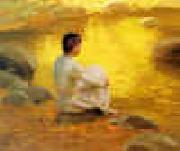 |
William Lees Judson
|
|
1842-1928
William Lees Judson was born in 1842 in Manchester, England, and moved to the United States with his parents when he was ten years old. After serving four years with the Illinois volunteers during the American Civil War, Judson studied art in New York and Paris. He settled in London, Ontario, where he became a successful portrait painter and art teacher. He moved to Chicago in 1890 but, suffering from failing health, he moved to Los Angeles in 1893. He settled on the banks of the Arroyo Seco in the Garvanza section of Los Angeles. A 1937 radio program noted that it was ??love at first sight?? when Judson saw the Arroyo Seco, and the area became his home for the rest of his life. Soon after his arrival, Judson was at the forefront of the Arroyo Guild of Craftsmen, an influential group of artists, sculptors and architects who fueled Southern California??s Arts and Crafts Movement. The beauty of the area stirred Judson to switch from portrait painting to landscapes, and his work attracted such favorable attention that in 1896 he was offered a professorship in drawing and painting at the University of Southern California. In the late 1890s, he founded the Los Angeles College of Fine Arts at his home in Garvanza (the present location of Judson Studios). In 1901, Judson's art college became USC??s College of Fine Arts, with Judson serving as dean from 1901 until his retirement in 1922. He died at his home in the studio building in October 1928. |
|
|
|
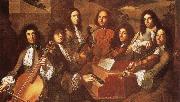 |
william wordsworth
|
|
Born: 7 April 1770
Birthplace: Cockermouth, England
Died: 23 April 1850
Best Known As: The author of the poem "Tintern Abbey"
|
|
|
|
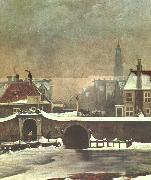 |
Wouter Johannes van Troostwijk
|
|
1782-1810
Dutch
Wouter Johannes van Troostwijk Gallery
Dutch painter, draughtsman and etcher. In 1803 he was admitted to the Amsterdam Tekenacademie where he was a pupil of the director, Jurriaan Andriessen. Despite a highly successful student career that culminated in a gold medal from the Felix Meritis Society in 1807, he was unable to establish himself as a professional artist during the remainder of his very short working life in Amsterdam. Andriessen's studies from nature seem to have been an important influence; van Troostwijk was one of the earliest artists to paint en plein air. Although he looked back to 17th-century Dutch landscape art and to the work of his contemporaries, in such paintings as Landscape in Gelderland (c. 1808; Amsterdam, Rijksmus.; see NETHERLANDS, THE, fig. 21) he achieved a totally new lyricism in the rendering of atmospheric effects. The Raampoortje (1809; Amsterdam, Rijksmus.) displays a fresh colouristic touch rare in Dutch painting of this period. His Self-portrait (c. 1810; Amsterdam, Rijksmus.) is equally original in composition and colour. He also produced animal paintings in the manner of Paulus Potter, drawings and a few etchings towards the end of his life. Van Troostwijk died before his considerable talents could be recognized, and, although he has come to be seen as an important precursor of much late 19th-century Dutch painting, he had little influence on his immediate successors. |
|
 |
WTEWAEL, Joachim
|
|
Dutch painter (b. 1566, Utrecht, d. 1638, Utrecht).
Dutch painter and draughtsman. He was one of the last exponents of MANNERISM. From c. 1590 until 1628, the year of his latest known dated paintings, he employed such typical Mannerist formal devices as brilliant decorative colour, contrived spatial design and contorted poses. He sometimes combined such artifice with naturalism, and this amalgam represents the two approaches Dutch 16th- and 17th-century theorists discussed as uyt den geest ('from the imagination') and naer 't leven ('after life'). Wtewael's activity reflects the transition from Mannerism to a more naturalistic style in Dutch art. Slightly over 100 of his paintings and about 80 drawings are known. Subjects from the Bible and mythology predominate; |
|
|
|
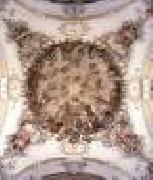 |
ZEILLER, Jakob Johann
|
|
German painter (b. 1708, Reutte, d. 1783, Reutte)
Austrian painter. Trained initially by his father, Paul Zeiller (1658-1738), he subsequently studied in Italy (1723-32) with Sebastiano Conca and at the Accademia di S Luca in Rome, and with Francesco Solimena in Naples, then at the Kaiserliche Akademie in Vienna. From 1733 to 1743 he was a regular collaborator on Paul Troger's frescoes, contributing mainly architectural frameworks painted in the style of the Bolognese quadraturisti. He retained such frameworks in his own paintings throughout his life, even in south Germany where this was generally unusual. Troger's influence on the style of Zeiller's figures and on his iconographic repertory was such that his first independent works in Austria |
|
 |
ZIMMERMANN Johann Baptist
|
|
German painter, Bavarian school (b. 1680, Wessobrun, d. 1758, Menchen).
Painter and stuccoist. Much of his early stuccowork and frescoes, such as that in the choir of Gosseltshausen parish church (1701) and the refectories of the abbeys at Tegernsee, Weyarn and Beyharting (before 1710), has been destroyed. His earliest surviving stuccowork (1707-9) is in the pilgrimage church of Maria Schnee, near Markt Rettenbach, and reveals the influences of Johann Schmuzer from Wessobrunn and an Italian stucco workshop that practised in Tegernsee. |
|
 |
ZOFFANY Johann
|
|
German/English painter (b. 1733, Frankfurt, d. 1810, Strand-on-the-Green)
|
|
 |
ZUCCHI Jacopo
|
|
Italian Painter, ca.1540-1596
Italian painter and draughtsman. He was trained in the studio of Vasari, whom he assisted in the decoration of the Palazzo Vecchio, Florence, as early as 1557. He accompanied Vasari to Pisa in 1561, from when dates his earliest known drawing, Aesculapius (London, BM). Between 1563 and 1565 he was again in Florence and is documented working with Vasari, Joannes Stradanus and Giovan Battista Naldini on the ceiling of the Sala Grande (Salone dei Cinquecento) in the Palazzo Vecchio; a drawing of an Allegory of Pistoia (Florence, Uffizi) is related to the ceiling allegories of Tuscan cities. In 1564 Zucchi entered the Accademia del Disegno and contributed to the decorations erected for the funeral of Michelangelo. He travelled to Rome with Vasari and was his chief assistant on decorations in the Vatican in 1567 and 1572, |
|
 |
ZUCCHI, Jacopo
|
|
Italian Painter, ca.1540-1596. Jacopo Zucchi was an Italian painter of the Florentine school. Italian painter and draughtsman. He was trained in the studio of Vasari, whom he assisted in the decoration of the Palazzo Vecchio, Florence, as early as 1557. He accompanied Vasari to Pisa in 1561, from when dates his earliest known drawing, Aesculapius (London, BM). Between 1563 and 1565 he was again in Florence and is documented working with Vasari, Joannes Stradanus and Giovan Battista Naldini on the ceiling of the Sala Grande (Salone dei Cinquecento) in the Palazzo Vecchio; a drawing of an Allegory of Pistoia (Florence, Uffizi) is related to the ceiling allegories of Tuscan cities. In 1564 Zucchi entered the Accademia del Disegno and contributed to the decorations erected for the funeral of Michelangelo. He travelled to Rome with Vasari and was his chief assistant on decorations in the Vatican in 1567 and 1572, |
|
|

